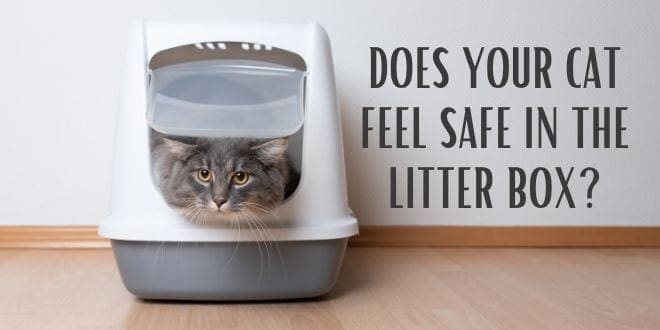
Litter Box Cleanliness
When it comes to the litter box, almost all cat parents know that cleanliness is important to cats. Unfortunately, that doesn’t mean all cat parents keep the box clean. One person’s idea of cleanliness may be totally unacceptable to another person. In most cases, if you aren’t keeping the box clean enough, your cat will let you know by choosing another location – one that meets her standards of cleanliness. Unfortunately, the location will probably be the living room carpet, the bathtub, the sink, the bathmat… you get the idea. Your cat’s alternative location probably won’t make you happy. Bottom line: you can never keep a litter box too clean.
Litter Box Safety
Another important aspect of litter box appeal has to do with something that isn’t even on the radar screens of most cat parents… safety. What I commonly find when I do in-home consultations that cat parents take the privacy issue too far and try to hide the litter box in the most remote locations, place boxes in cabinets, behind furniture, or they purchase covered boxes. Although it’s certainly not appealing to have the litter box front and center in the middle of the family room, your cat actually doesn’t want the location to be too private or remote either. The reason has to do not only with convenience, but with safety. Yes, safety!
Even though you have created a comfortable and convenient environment for your cat when it comes to the litter box (from your point of view), she doesn’t necessarily interpret it that way. This is especially true in a home where there are multiple companion animals. When a cat is taking care of some very personal business in the litter box, it isn’t the time she should have to be concerned about a companion cat ambushing or stalking her by waiting at the litter box entrance or or just around an unseen corner.
Covered Boxes Can Cause Problems
Covered boxes are appealing to humans but not to the majority of cats. Humans like covered boxes because they trap the odor, reduce litter scatter, and the big daddy reason of them all — no one really wants to look at the deposits made in the box. Unfortunately for the cat, the cover on the box can cause her to feel vulnerable if she’s worried that a companion cat may trap her in there. A covered box limits the cat’s escape potential because there’s only one way in and one way out. Some covered boxes have flaps on them as well and that further restricts the warning time a cat would have to see if an opponent is approaching the box or even lurking right outside the entrance.
In your attempt to provide privacy at the litter box, you may have located it in a closet or even hidden it in a closed cabinet with a cat flap. There are even some litter boxes on the market these days that are disguised as planters or end tables. You can also find top entry boxes. Imagine the poor cat who finds herself getting ambushed from ABOVE. Yikes! Don’t be tempted to purchase fancy litter boxes in an effort to provide privacy for your cat. These products could end up being an expensive mistake if your cat feels too trapped in there.
When a cat needs to eliminate, the area she chooses should provide cleanliness, comfort, convenience, safety and escape potential. If the cat lives in a multipet home (especially a hostile or cat-dense one), the need for escape becomes even more crucial. Adequate warning to see an approaching opponent, as well as more than one exit route must be factored in when deciding on the type of box to buy. Where to locate the box must also be a strong consideration. If your cat is eliminating outside of the box in your home and she lives in a hostile multipet environment, you may find the areas chosen for elimination are more open, allowing enough visual warning time and more than one escape option.
Think Like a Cat
Sometimes the solution is as simple as removing the litter box cover or sliding the box out from the closet. I often advise placing the box on the side of the room opposite the entrance. The more warning time the cat has, the better. When choosing a litter box location, get down on the cat’s level and you’ll see her world from a totally different perspective.
In multicat homes you should carefully choose locations for the litter boxes. Just having seven litter boxes for seven cats isn’t adequate enough if all the boxes are lined up in one room. Take into consideration that one cat may not want to cross another cat’s preferred location. Litter boxes should be scattered around to reduce the chances of confrontation. If a cat feels frightened about crossing another cat’s location just to get to the litter box, she may decide it’s easier to just pee or poop on the carpet rather than risk a physical fight. Additionally, if she knows there’s a good chance she’ll get ambushed while in the box she’ll probably avoid that box altogether. That’s why it’s up to the cat parent to create a safe environment when it comes to the litter box set-up. Humans can lock the bathroom door to ensure no one barges in on them but cats don’t have that option. Ideally, you should more litter boxes than cats and the boxes should be scattered around the house so each cat has at least one box in their own preferred core area.
Note: There are, of course, many reasons a cat may not use the litter box, so if your cat has begun eliminating outside of the box, please consult your veterinarian.
Unsure About Whether Your Cat Feels Safe in the Litter Box?
Your cat’s behavior in the box can provide clues as to whether she’s at ease or nervous in there. A nervous cat may jump in, eliminate and then bolt right out of there because she doesn’t want to risk drawing attention to her presence. There are, of course, several other reasons why a cat may do a hit-and-run elimination attempt, so make sure you’ve addressed any potential medical issues as well as doing a good job of keeping the box clean. If you’re unsure about whether your cat is uncomfortable or nervous, set up a surveillance camera near the box so you can watch her behavior as she approaches, enters, and exits. On video, you may discover the approach of another cat or some kind of interaction that creates stress. Video is a great way to gather evidence in order to find the most accurate and effective solution. Video can also be used to show your veterinarian if you have questions.
Need More Information on Cat Behavior?
You can find specific information on how to create a litter box set-up and address litter box problems in the best-selling books by Pam Johnson-Bennett. Her books are available at bookstores and online. We’ve included Amazon links here on our website.
If you have a question regarding your cat’s health, please contact your veterinarian. This article is not intended as a replacement for your cat’s veterinary care.




